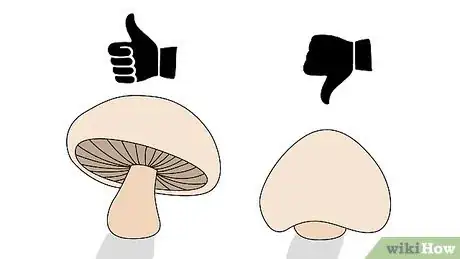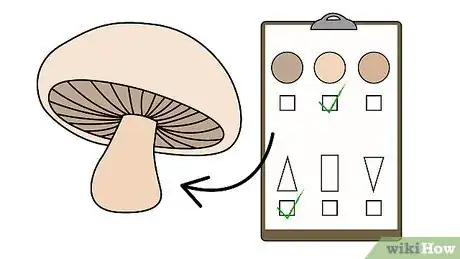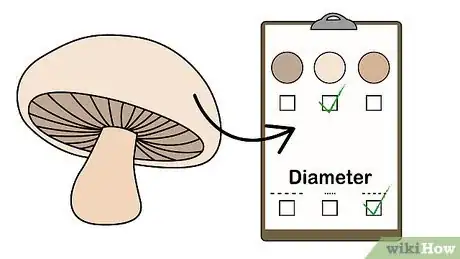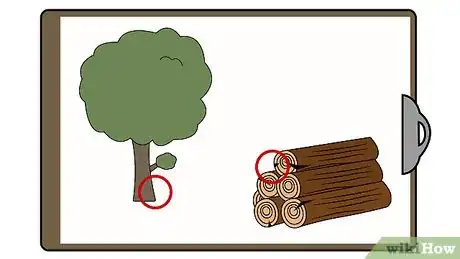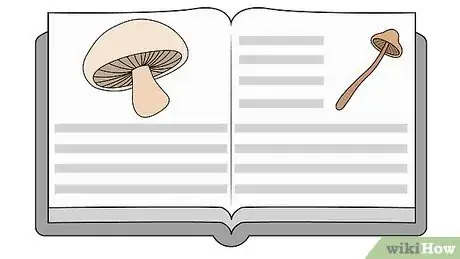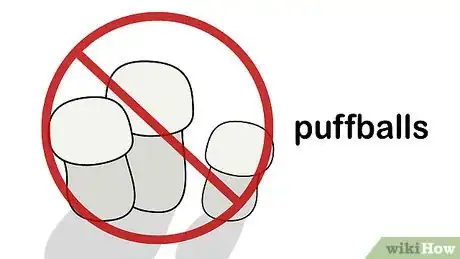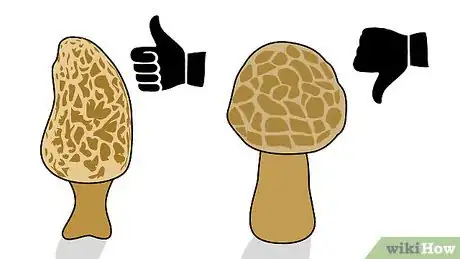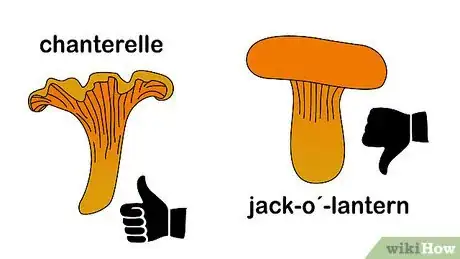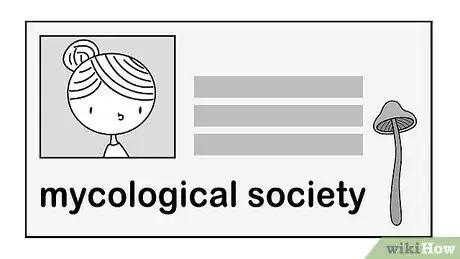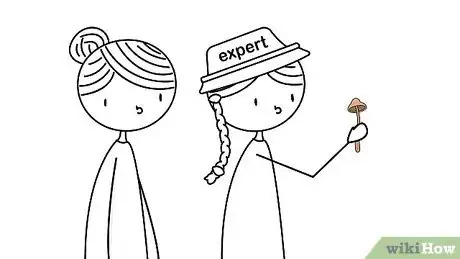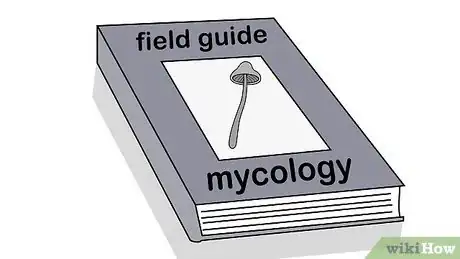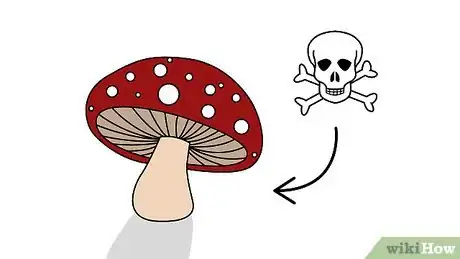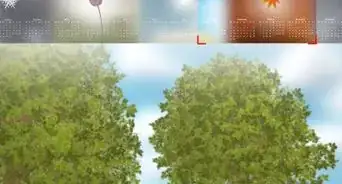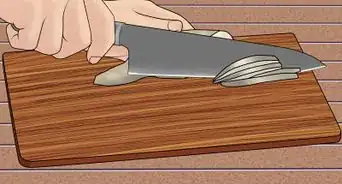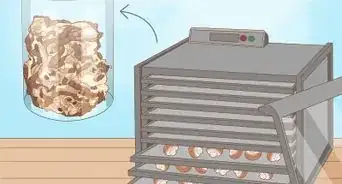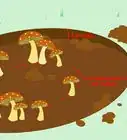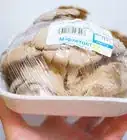This article was co-authored by Olivia Choong. Olivia Choong is a Plant and Gardening Specialist and the Owner of The Tender Gardener. With more than six years of experience, she specializes in gardening, permaculture, and self-sufficient and low-impact living practices. Her work has been featured in media outlets such as The Straits Times and Channel NewsAsia (CNA). Olivia holds a Bachelor of Mass Communications in PR and Journalism from Murdoch University.
There are 13 references cited in this article, which can be found at the bottom of the page.
This article has been viewed 137,638 times.
Foraging for wild mushrooms is an increasingly popular hobby. Going on forays with friends is one of the most fun ways to spend spring and fall afternoons! There are known characteristics you can look for to make sure you’re picking safe mushrooms, but there still may be risks involved, especially if you plan to eat them. Consider getting proper training and advice from expert mycologists. If you are curious about this fun hobby, you may want to join your local mycological society.[1]
Steps
Foraging Safely
-
1Forage with two baskets. When you positively identify a mushroom, put it in your edible mushrooms basket. If you pick a mushroom but don’t know what it is or feel unsure about its identity, put it in the other basket.[2]
-
2Avoid picking mushrooms in the button stage. Because people often confuse mushrooms at the button stage, you should stick to picking mushrooms that have opened caps.[3] [4]Advertisement
-
3Pick the fleshy mushrooms. You want to pick the edible mushrooms when they look fresh and fleshy. Cut the mushrooms with a clean and sharp knife, as close as possible to the base.[5] Put them in a basket. When you get home, put them in a closed paper bag in the refrigerator.
- If they look old or decaying, leave them in the ground.
- They should store for a week at home.
- Be sure to dig your mushroom out in a way that leaves the base of the stalk undamaged! Do not pull it up. Replace the soil when you are done. Some mushrooms have important features, such as an easily destroyed sac, at the base of the stipe.
-
4Follow the golden rule. If you have any doubts at all about a mushroom that you have picked in the wild, toss it! Give yourself some time to learn the nuances of mushroom picking. After all, it’s not worth risking your life for a delicious meal. You are better off being cautious when it comes to eating mushrooms that you have foraged in the wild.[6]
- “When in doubt, throw it out!”
- If the mushroom looks good but there is something that bothers you about where you picked it, it’s not worth taking the chance!
-
5Ignore misleading rules of thumb. You may hear a number of misleading rules of thumb from people who like to hunt for wild mushrooms. However, there are no easy shortcuts to proper mushroom identification. As such, ignore the following rules of thumb:
- “If an animal has nibbled the mushroom, it is fine.” This is not true.
- “You can get rid of poisons by cooking the mushrooms.” This is also false. Although cooking will get rid of harmful bacteria and make edible mushrooms much more digestible, you can’t make a poisonous mushroom edible by cooking it!
- “Mushrooms that smell good must be edible.” This is simply not true.
-
6Store and transport the mushrooms safely. Mushrooms should be carried in paper bags or waxed paper, preferably in a rigid container. Smaller mushrooms can be kept intact by carrying them in a small, hard box. Some tackle boxes used for holding fishing flies are ideal for this purpose!
- Plastic sandwich bags will turn them to unidentifiable mush.
Identifying Mushrooms
-
1Smell the mushroom. Kneel down next to the mushroom you wish to identify. Put your nose right next to the gills of the mushroom and inhale deeply. Think of a few adjectives to describe the smell, such as sweet or smokey, and use these adjectives to start the identification process.
- How does your mushroom smell?
- Does the mushroom smell generically fungal or phenolic?
- Don’t taste the mushroom until you have finished the complete identification process.
-
2Look at the shape and texture of the gills. Look at the gills on the underside of the mushroom to see whether they are clearly delineated or mushy looking. You’ll also want to look at how they connect to the stalk. The texture is also important to consider, as well as whether any liquid oozes from the gills. By asking yourself questions about the gills, you can begin the identification process:[7]
- Are the gills covered by a veil of thin, felt-like, or cobwebby tissue?
- See if the gills are connected to the stalk. If so, do they run down the stalk, meet it at a right angle, or barely touch it? This character, like color, can change in age!
- Does your mushroom have plate-like gills under the cap surface, wrinkles, spongy tubes, or something else?
- Do you see liquid oozing from the gills?
-
3Examine the size and color of the stalk. You’ll need to take mental notes about the size, color and shape of the stalk. You’ll want to look at any characteristics of the skin covering the stalk, as well as the connection between the stalk and the gills.
- Look at the size, color and shape of the stalk.
- Is a stalk (stipe) present or absent?
-
4Take notes about the size and color of the cap. You’ll want to take detailed notes about the size of the cap. Then, describe any variation in the color of the cap, as well as whether there are any spots on it. Finally, the texture of the cap is important to consider, such as whether it is smooth or slimey. Ask key questions about the cap:
- What is the diameter of the mushroom cap?
- Are there colorful spots on the cap?
- Look at the color of the cap.
- What color is the flesh inside the cap?
- Does your mushroom bruise when cut or crushed? What color?
-
5Take detailed notes about the location. Take out your notebook. Look at your surroundings. Take detailed notes about your find in relation to the features of the landscape, such as trees, soil type, forest, other fungi, leaves, animals. These notes will help you make an accurate identification.[8]
- A GPS locator is an excellent tool here!
- Is the mushroom growing on dead wood, living tree, soil, moss, or something else entirely?
- While fungi can form associations with many plants, trees are the most relevant to identification. If you can't tell the species of tree exactly, at least note whether conifers, hardwoods, or both are present. Which trees are present in the area?
- Make a note if your mushroom is growing in a lawn, on sand, on moss, on another mushroom, or any other site of interest.
-
6Take a photograph of the mushroom before picking it. Try to get a few angles and include some of the surrounding landscape in some of the shots. When you are identifying the mushroom and consulting experts, you can compare your shots to the field guide. You can also show them to experts in order to confirm your identification.
-
7Obtain a mushroom spore print. Because the color of a mushroom’s spores is useful for identification, you could make a spore print at home. Cut off the stem of the mushroom and place the cap down on a piece of paper. Place a cup over the mushroom. Wait overnight and then remove the cup and the mushroom to see the spore print. If the mushroom is dropping spores, you will see them dusting the paper, allowing you to determine their color.[9]
- If you anticipate a dark spore print, you should use white paper.
- If you anticipate a white or light spore print, you should use dark paper.
- If you have a sheet of glass, you can use it for the spore print.
- The terms for spore color can be very precise. Chocolate brown, tobacco brown, and rusty brown are entirely different colors!
Spotting Toxic Look-alikes
-
1Use multiple sources to make an identification. When you get back to the picnic table or kitchen, look at the mushroom again. Use one book to identify it. Then, identify the mushroom using a second source, such as another book or article on the species.[10]
-
2Don’t skip any steps in the identification process. Although you may be eager to apply your mycological knowledge in the field, you should avoid jumping to any conclusions during the identification process. If you think it is an edible mushroom, examine all of its characteristics to make sure it is not a toxic look-alike.[11]
- For example, Volvariella speciosa, a popular edible species in Asia, can be easily confused with Amanita phalloides, a deadly poisonous species in North America and Europe.[12]
-
3Avoid picking puffballs. If you see a mushroom that looks like the puffball mushrooms you are familiar with from the supermarket or television, you should skip it. Beginners are especially forewarned to avoid picking puffballs, since they can easily be confused with poisonous amanitas.[13] The mushrooms that look most familiar to a beginner mycologist, such as puffballs, could easily be confused with a poisonous young amanita mushroom.[14]
- You should also avoid the little brown mushroom, which is poisonous. It also looks a bit like the mushrooms you see in a supermarket.
-
4See the difference between a morel and a toxic false morel. Whereas a morel is perfectly hollow inside, a false morel looks like a brain on the inside. Don’t let commonalities like the dimpled appearance and the fact that they fruit at the same time confuse you. If you pick a morel, look on the inside. If it is brain-like on the inside as well as the outside, it is a false morel. [15]
-
5Don’t confuse the jack-o’-lantern with the chanterelle. The best way to differentiate a chanterelle mushroom, which is edible, from a jack-o’-lantern, which is poisonous, is to look at the gills. A chanterelle mushroom has fake gills that run down the stem and are not easily removed from the cap. They look like they have been melted. In contrast, a jack-o’-lantern has true gills that look like little blades that don’t run down the stem.[16]
- A jack-o’-lantern or false chanterelle is deep orange. In contrast, a chanterelle mushroom can be anything from light yellow or orange yellow.
- Whereas jack-o’-interns grow in bunches that are attached at the stem, chanterelles like to grow alone or in small bunches and with separate stems.
Getting Proper Training
-
1Join a mycological society. One of the best ways to learn about picking wild mushrooms is to join a local mycological society. After joining, you will get invitations to forays at local parks where you can learn from experienced mushroom pickers. You may also get invited to special mushroom dinners and lectures on the science of mycology.
- You will typically pay a small membership fee.
- For instance, the Wisconsin mycology society has forays, lectures, dinners and workshops on mushrooms.[17]
- The Mycological Society of Toronto runs forays in the spring and fall picking seasons, hosts dinners and runs lectures. It also has a quarterly newsletter called “Mycelium.” [18]
-
2Take a mushroom identification course. Once you are a member of a mycological society, you will have access to mushroom identification courses.[19] One of the best things you can do is take a day-long course that reviews the fundamentals of where to look for particular species, when to harvest different species and how to avoid poisonous look-alikes.[20]
-
3Go on forays with experienced mycologists. The best way to learn how to pick mushrooms is by picking with an experienced mycologist. Go on a hike with someone who is both knowledgable and passionate about mushrooms. Pick their brain about how to safely forage for wild mushrooms.[21]
- If you are part of a mycological society, you should be able to meet some fellow mushroom loving friends at one of the forays.
-
4Purchase a field guide to mycology. You should pick up at least one general book on mycology and one field guide that focuses on your particular region. Whereas the general mycology book will review the fundamentals of mushroom picking, your field guide will offer tips that are specific to the place where you want to pick them.[22]
- For instance, a good introduction is How to Identify Edible Mushrooms by Tony Lion and Gill Tomblin.
- Mushrooms by Roger Phillips is a good place to start.
- You might be interested in Mushrooms: River Cottage Handbook No 1.
-
5Avoid misleading information and images online. You can’t teach yourself to be a mycologist by just looking at a few images of edible mushrooms online. Rather than searching with the “images” function on your search engine, you should consult reputable books on mycology and ask experts for help with identification.[23]
-
6Learn about dangerous mushrooms. To avoid picking the wrong mushroom, you should familiarize yourself with both poisonous and difficult to identify species. If you are a beginner, for instance, you should avoid picking lactarius and russula species. Read the notes in your field guide about the dangerous mushrooms in your region.[24]
- Avoid poisonous species like amanita, galerina, entoloma and cortinarius.
Expert Q&A
-
QuestionIs it better to cut or pull mushrooms?
 Olivia ChoongOlivia Choong is a Plant and Gardening Specialist and the Owner of The Tender Gardener. With more than six years of experience, she specializes in gardening, permaculture, and self-sufficient and low-impact living practices. Her work has been featured in media outlets such as The Straits Times and Channel NewsAsia (CNA). Olivia holds a Bachelor of Mass Communications in PR and Journalism from Murdoch University.
Olivia ChoongOlivia Choong is a Plant and Gardening Specialist and the Owner of The Tender Gardener. With more than six years of experience, she specializes in gardening, permaculture, and self-sufficient and low-impact living practices. Her work has been featured in media outlets such as The Straits Times and Channel NewsAsia (CNA). Olivia holds a Bachelor of Mass Communications in PR and Journalism from Murdoch University.
Plant & Gardening Specialist Both methods work! To pull a mushroom, gently grip the base and twist it in an anti-clockwise direction, pulling it off the mycelium from which it grows. Try not to damage the mycelium in the process!
Both methods work! To pull a mushroom, gently grip the base and twist it in an anti-clockwise direction, pulling it off the mycelium from which it grows. Try not to damage the mycelium in the process! -
QuestionIs a big and flat mushroom I found at the top of the body of a dying big tree safe to eat?
 Community AnswerNo.
Community AnswerNo. -
QuestionIs the mushroom in the spore print section on the guide upside down?
 Community AnswerYes, it should have the the stem cut off and be faced down so the spores can be released.
Community AnswerYes, it should have the the stem cut off and be faced down so the spores can be released.
Things You’ll Need
- Baskets
- Sharp knife[25]
- Field guide to mushroom picking
- Notebook
- Paper
- Cup
Warnings
- If there will be any children or pets near the mushrooms, make sure that the two never meet.⧼thumbs_response⧽
- Be aware of any laws against collecting from public lands in your area. You can be hit with a hefty fine for collecting without a license, even if you don't intend to eat what you collect! In addition, you may want to avoid collecting anything that resembles a hallucinogenic species; possession of Psilocybe is a crime in many jurisdictions.⧼thumbs_response⧽
- Don’t rely on online information to learn the science of mycology. For instance, reading this article is no substitute for learning mycology in a course or from experts in the field.⧼thumbs_response⧽
- Be careful with your dogs. Since dogs are frequent victims of poisoning from mushrooms, you should exercise caution when taking them mushroom picking.[26]⧼thumbs_response⧽
- Several deadly or seriously toxic mushroom species resemble edible species. Do not eat wild mushrooms unless you have forayed with a knowledgeable group --doing so entails the following risks:
- Severe vomiting and/or diarrhea
- Decreased blood pressure
- Difficulty breathing, possibly death due to respiratory failure
- Drowsiness (falling asleep and unable to be roused) leading to a misdiagnosis of a comatose state
- Kidney and liver failure
- Cancer (Gyromitrin is a known carcinogen)
- Hemolytic anemia
⧼thumbs_response⧽
References
- ↑ https://www.theguardian.com/lifeandstyle/2010/sep/16/wild-mushroom-picking
- ↑ https://www.mnn.com/your-home/organic-farming-gardening/stories/wild-mushrooms-what-to-eat-what-to-avoid
- ↑ http://mushroom-collecting.com/mushroomcollecting2.html
- ↑ Olivia Choong. Plant & Gardening Specialist. Expert Interview. 3 September 2021.
- ↑ Olivia Choong. Plant & Gardening Specialist. Expert Interview. 3 September 2021.
- ↑ https://www.theguardian.com/lifeandstyle/2010/sep/16/wild-mushroom-picking
- ↑ https://www.mushroom-appreciation.com/mushroom-identification.html#sthash.xb76MQSX.dpbs
- ↑ http://mushroom-collecting.com/mushroomcollecting2.html
- ↑ http://www.mushroomexpert.com/spore_print.html
- ↑ http://mushroom-collecting.com/mushroomcollecting2.html
- ↑ https://www.mnn.com/your-home/organic-farming-gardening/stories/wild-mushrooms-what-to-eat-what-to-avoid
- ↑ http://en.wikipedia.org/wiki/Mushroom_poisoning
- ↑ http://mushroom-collecting.com/mushroompuffball.html
- ↑ http://grist.org/food/how-to-pick-mushrooms-without-poisoning-yourself/
- ↑ https://www.mnn.com/your-home/organic-farming-gardening/stories/wild-mushrooms-what-to-eat-what-to-avoid
- ↑ http://www.mushroom-appreciation.com/chanterelle-mushrooms.html#sthash.qTXhUmk6.dpbs
- ↑ http://www.wisconsinmycologicalsociety.org/
- ↑ https://www.myctor.org/membership/resources/services
- ↑ https://www.myctor.org/membership/resources/services
- ↑ http://www.wildernesscollege.com/wild-mushroom-identification.html
- ↑ https://www.theguardian.com/lifeandstyle/2010/sep/16/wild-mushroom-picking
- ↑ https://www.theguardian.com/lifeandstyle/2010/sep/16/wild-mushroom-picking
- ↑ https://www.mnn.com/your-home/organic-farming-gardening/stories/wild-mushrooms-what-to-eat-what-to-avoid
- ↑ http://mushroom-collecting.com/mushroomcollecting2.html
- ↑ Olivia Choong. Plant & Gardening Specialist. Expert Interview. 3 September 2021.
- ↑ https://www.mnn.com/your-home/organic-farming-gardening/stories/wild-mushrooms-what-to-eat-what-to-avoid
About This Article
To pick mushrooms, look for ones that are fresh and fleshy, without any signs of decay. Additionally, only pick mushrooms with fully opened caps, since it's hard to tell the difference between edible and poisonous mushrooms when the caps are closed. You should also throw away any mushrooms you're unsure about as it's not worth the risk of eating one that's poisonous. Once you've finished picking your mushrooms, transport them home in a basket and store them in a paper bag. For tips on how to identify different types of mushrooms, keep reading!

